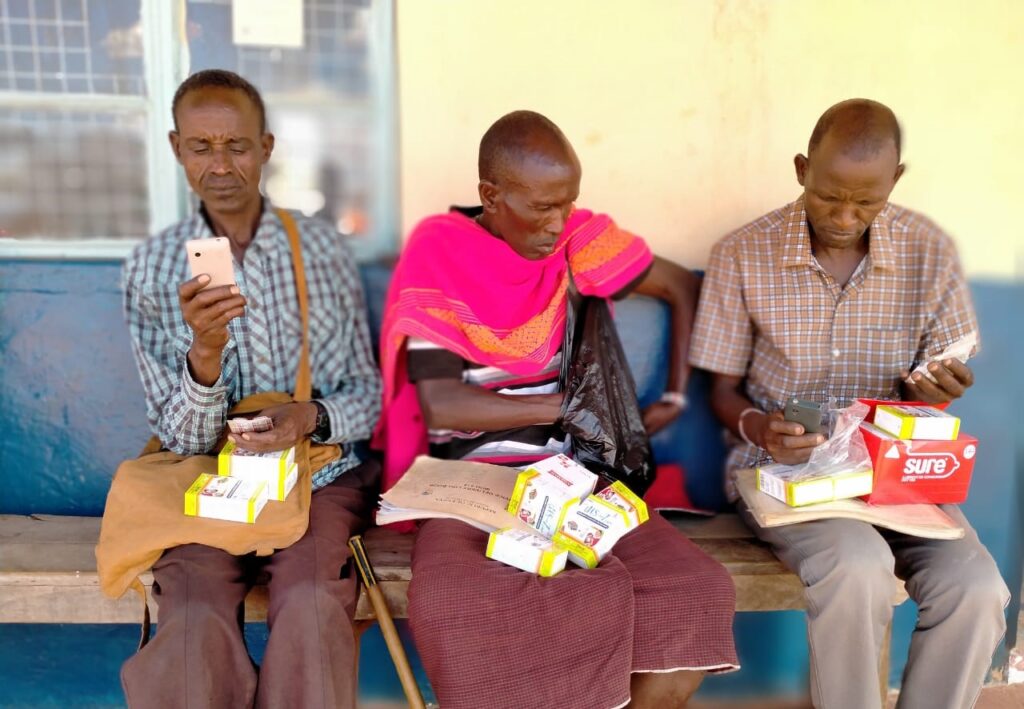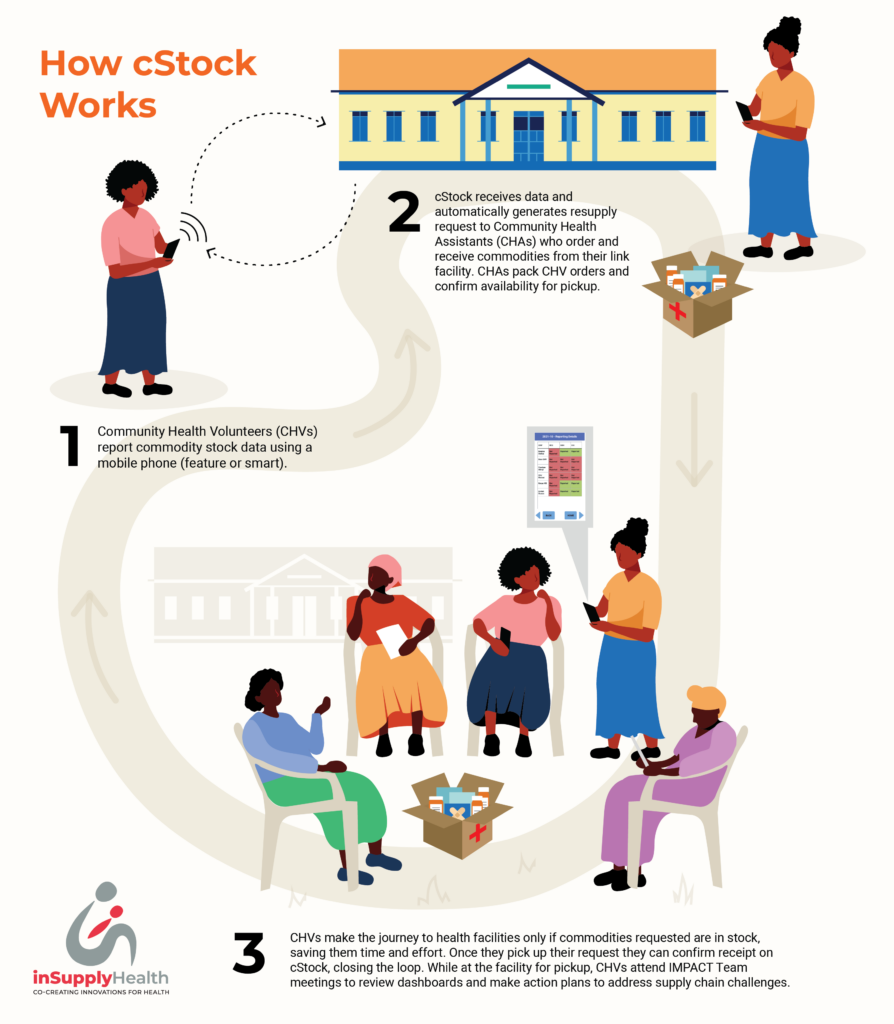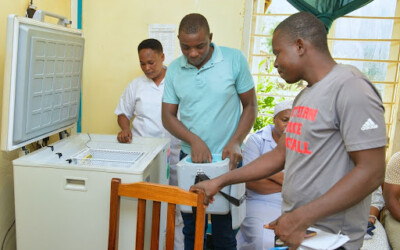
Like many countries in sub-Saharan Africa, Kenya’s healthcare system grapples with various supply chain challenges. This includes poor infrastructure, network connectivity challenges, and the intermittent supply of medicines, often leading to stockouts. In addition, inadequate quantification methods and accountability mechanisms for commodities issued at the community level negatively affect the inventory management of essential medicines and supplies. Community Health Promoters (CHPs) are pivotal in providing critical health services and ensuring that medicines and supplies reach those in need. They are authorized to test and treat minor ailments before referring patients for further management at the health facilities. This means that they are often the first point of contact with patients within the community. However, without proper reporting tools and resources to carry out basic inventory management processes, the CHPs cannot address the supply chain issues effectively. In addition, using paper-based systems has made it more difficult to track inventory or accurately predict demand. The lack of real-time data further complicates efforts to streamline the supply chain and ensure that health facilities are adequately stocked with essential life-saving medications.
inSupply Health introduced cStock as a unique solution to bridge the gap in transparency and accountability for commodities at the community level. This innovative supply chain strengthening approach combines mobile technology for CHP reporting and resupply, dashboards for enhanced data visibility and supply chain transparency, and data use teams (the IMPACTT Approach). The design of cStock is centered around introducing a data-use culture, thereby empowering health workers to consistently use data to strengthen the supply chain.
Promoting a Human-Centered Design
A pilot test of cStock was first conducted in the Bondo and Ugunja sub-counties in Siaya County in Western Kenya. The inSupply Health team then used a Human-Centered Design (HCD) approach to gather lessons learned, generate ideas, and focus on user experience. This strategy was adapted for scale in four additional counties in the country’s arid and semi-arid lands: Turkana, Wajir, Samburu, and Mandera, where health commodity management is complex. The tool was then rolled out to CHPs in 15 sub-counties, 11 of which had a substantial segment of nomadic communities. The successful implementation across diverse settings highlights the adaptability and potential of cStock.
The feedback received from initial users influenced the tool’s redesign. Since many CHPs in nomadic communities have difficulties with internet access, the tool was redesigned to work on basic mobile phones, equipped with an Unstructured Supplementary Service Data (USSD)-based technology that does not require an internet connection. This would enable the CHPs to effortlessly manage their inventory by transmitting real-time information to healthcare workers, who could address potential supply chain challenges. A portal was developed, allowing the Community Health Assistant (CHA) to delegate reporting, support the management of CHPs and products, view the stock levels of CHPs, resupply commodities, and monitor inventory. cStock sent messages to prompt and remind the CHAs to submit CHP reports and resupply orders. On the CHP side, these prompts encouraged them to submit reports or receive supplies from the CHA. For example, in Turkana County, CHPs could convert the photo capture of the manually written reports to digital reports using the hybrid paper-to-digital solution.

Bridging a Health Care Gap
The introduction of cStock marked a significant shift in how logistics data on essential medicines was collected and utilized for community supply chain management in the different settings in Kenya. The nomadic lifestyle in Northern Kenya means that communities move frequently, and this presents a unique set of issues as the CHPs must be mobile and adaptable, often traveling long distances to reach different community groups. The tool enabled CHPs to report directly on stock levels, demand, and supply chain challenges such as stockouts. Moreover, the data collected influenced decision-making at the facility and sub-county levels, ensuring that essential medicines are more effectively distributed.
By capturing data in real-time, CHPs supported the achievement of the Community Health Strategy’s goal to enhance service delivery for all Kenyans through integrated, participatory, and sustainable community health services, advancing the attainment of Universal Health Coverage (UHC).
Results and Impact on the Healthcare System
The data-driven approach also allowed for better planning and resource allocation, optimizing the supply chain and reducing wastage. After inSupply Health rolled out cStock, 3,230 CHPs and 223 CHAs used the application to report on their consumption and commodities received and to make emergency reports when re-order levels were reached or stockouts occurred. In March 2022, the reporting rates were 73 percent for consumption and 50 percent for commodities received. Stock reporting was linked to resupply, with replenishment quantities displayed on the CHA dashboard for each CHP and automatically calculated based on supply chain principles. The dashboard helped the CHAs monitor the CHPs’ performance and provide accountability for health commodities. The CHAs improved data quality by using the portal to validate logistics data reported by CHPs. In addition, there was increased visibility of community health commodities data through the dashboards and the Kenya Health Information System (KHIS).
The figure below demonstrates the steady increase in reporting rates across the counties following the implementation of cStock in October 2020. However, the reporting experienced intermittent pauses because of health workers’ strikes and commodity unavailability.

Learning Opportunities
Implementing cStock required the team from inSupply Health to be flexible and adaptable by adopting a cascaded approach to training. The tool also enabled counties to efficiently track consumption and improve the process of issuing commodities to CHPs. In addition, CHPs were recognized for their outstanding work at the community level, including providing health education and services to families who may not otherwise have access to care. Engaging CHPs and other stakeholders ensured that the solutions developed were practical and met the actual needs of the users. The process also underscored the need for continuous training and support. While cStock was designed to be user-friendly, ongoing training sessions were necessary to ensure the CHPs could use the tool effectively and troubleshoot any issues. This is because the needs of nomadic communities differ from those of settled populations, requiring tailored solutions. The HCD approach was instrumental in cStock’s success. By focusing on the needs and experiences of the end-users—CHPs and the communities they serve—the design process ensured that the solutions were practical and embraced by those who used them. This fostered a sense of ownership and empowerment.
Next Steps
The cStock story is one of innovation, resilience, and community spirit and a testament to what can be achieved when we bridge the gaps and connect the dots in our healthcare systems. Integrating technology and data-driven approaches, coupled with the empowerment of local health workers, offers a blueprint for addressing healthcare challenges in remote and underserved areas. As Kenya strives towards universal health coverage, the lessons learned from using cStock have galvanized the government to take steps in the right direction regarding using digital tools to improve the health system. In 2023, Kenya introduced the electronic community health information system (eCHIS), which captures data on services and commodities. This triangulates the data from the services and the commodity management component within eCHIS and uses a variation of cStock, which assists the CHP in data reporting. Although cStock is not presently being used in the nomadic communities, where it was successfully introduced and implemented, the story is still ongoing. There has been strong interest from inSupply Health’s implementing partners in Kenya in customizing cStock for other settings. One of the factors that have contributed to this is the sustainability of the design, which is a direct result of the HCD approach and a strong indication that involving the users in all the steps of intervention will inevitably yield solid results.



